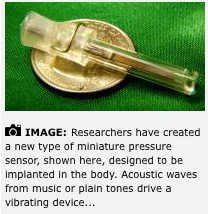All those King Tubby kickdrum booms were bound to have a practical use.
Somewhat like when Rufus explains in Bill and Ted's Excellent Adventure that the Wyld Stallions' music has energies sufficient to align the planets, it now turns out that all that lovely walloping bass in hip-hop riddims can actually be put to use charging medically implanted devices. Specifically devices designed to alleviate incontinence. And whilst it may well work, Trebuchet can only reflect on the bowel-loosening effects of spending too much time if front of the bass bins.
The driving bass rhythm of rap music can be harnessed to power a new type of miniature medical sensor designed to be implanted in the body.
Acoustic waves from music, particularly rap, were found to effectively recharge the pressure sensor. Such a device might ultimately help to treat people stricken with aneurisms or incontinence due to paralysis.
The heart of the sensor is a vibrating cantilever, a thin beam attached at one end like a miniature diving board. Music within a certain range of frequencies, from 200-500 hertz, causes the cantilever to vibrate, generating electricity and storing a charge in a capacitor, said Babak Ziaie, a Purdue University professor of electrical and computer engineering and biomedical engineering.
the acoustic energy from the music can pass through body tissue, causing the cantilever to vibrate
"The music reaches the correct frequency only at certain times, for example, when there is a strong bass component," he said. "The acoustic energy from the music can pass through body tissue, causing the cantilever to vibrate."

When the frequency falls outside of the proper range, the cantilever stops vibrating, automatically sending the electrical charge to the sensor, which takes a pressure reading and transmits data as radio signals. Because the frequency is continually changing according to the rhythm of a musical composition, the sensor can be induced to repeatedly alternate intervals of storing charge and transmitting data.
"You would only need to do this for a couple of minutes every hour or so to monitor either blood pressure or pressure of urine in the bladder," Ziaie said. "It doesn't take long to do the measurement."
Findings are detailed in a paper to be presented during the IEEE MEMS conference, which will be Jan. 29 to Feb. 2 in Paris. The paper was written by doctoral student Albert Kim, research scientist Teimour Maleki and Ziaie.
"This paper demonstrates the feasibility of the concept," he said.
Source: Purdue University

The aim of art is to represent not the outward appearance of things, but their inward significance. – Aristotle














